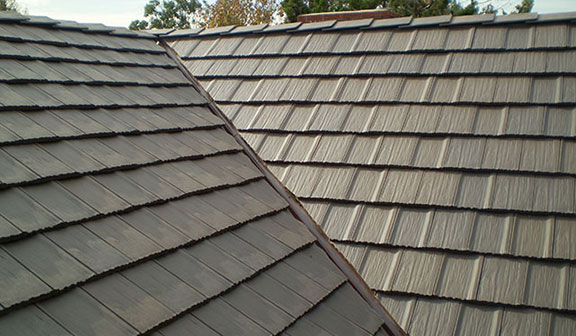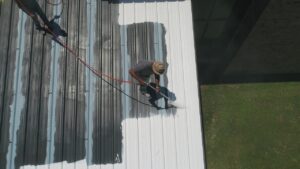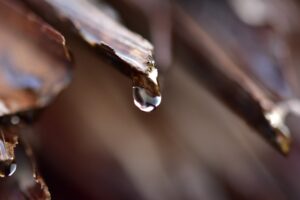
COMPOSITION SHINGLE
TYLER COMPOSITION SHINGLE INSTALLATION
Most Tyler roofers refer to composition shingles as asphalt shingles. They are by far the most widely used type of roofing material in the United States. They are also the least expensive. The majority of asphalt shingles are made using a fiberglass mat that is placed between two layers of asphalt although some asphalt shingles have a paper layer in the middle instead. To protect the asphalt shingle from the sun’s UV rays, the manufacturer embeds tiny stones in the top of the shingle.
Asphalt shingles are available in a wide variety of colors, styles, designs, sizes and weights. Their lifespan is from 15 to 20 years depending on their level of durability. Fiberglass shingles are more fire resistant than those with a paper interior. Fiberglass shingles are more popular among homeowners and Tyler residential roofing companies because they last longer. To reduce cooling costs, you should order lighter-colored asphalt shingles that will reflect sunlight better than black or darker colors. Sometimes you can recycle asphalt shingles, but they are not usually regarded as an environmentally friendly roofing material.
There are two kinds of composition shingles, fiberglass and organic. Organic shingles are waste or recycled paper that is saturated with asphalt to make them waterproof and then a top coating of adhesive asphalt is applied with ceramic granules embedded on top. The basic three-tab asphalt shingle has slits in the front. The shingle looks like it has three smaller shingles.
Architectural shingles are an upgrade to standard composition shingles. They are also referred to as laminated or dimensional shingles. They are composed of two layers that are bonded together with an asphalt sealant. Architectural shingles can last 30 to 50 years thanks to their lamination and because they are thicker than basic shingles. They are more expensive, but they have a gorgeous, multi-dimensional effect on a roof. They are more resistant to fire and high winds as well. They do not have slits in them, so debris cannot accumulate so easily on a roof. Their textured look is preferred by most people. The longer lifespan makes architectural shingles the greenest type of composition shingles.
BENEFITS OF ASPHALT SHINGLES
Asphalt shingles are among the least expensive roofing materials made. Every professional East Texas roof company knows how to install them. Certain composition shingles can withstand hail. They provide good fire resistance and may come with wind warranties up to 130 mph. Some of them incorporate zinc or copper to reduce the growth of algae. They do need to be cleaned periodically to get rid of any accumulated debris. Some types of asphalt shingles have a reflective coating, which helps to lower your home’s cooling costs. Even though they can be recycled, most used asphalt shingles wind up in landfills.
SLATE ROOFS
SLATE ROOF INSTALLERS
If you want your home to have a stately appearance and be well protected, slate is a wise option for your roof. It is a natural stone formation that is easily split into thin sheets. Those thin sheets are then sliced into 3/16-inch (5 mm) roofing shingles that are exceptionally durable. Due to its weight, slate resists wind very well and provides lasting protection against driving rains. Large hailstones are among the few things that can harm a slate roof.
Slate is available in a wide variety of natural shapes and colors, such as green, red, black and gray. Because it is so beautiful and durable, it is frequently installed by a roof company on historic homes, government buildings and libraries. A slate roof can last anywhere from 60 to 200 years depending on the quality of the slate. Its natural beauty enhances the appearance of any building.
It can be laid in a large variety of patterns to achieve different appearances. Like clay tiles, slate’s biggest drawback is that it is very heavy. Slate is a low-maintenance roof covering that is more expensive than most roofing materials and a professional installation may require extra support for the roof.
A roofer must have special training to install slate because it is hung from nails and is not glued to the roof. It needs to be handled properly because it can be broken during the installation. Slate works best on steeply sloped roofs that shed water easily. Since it is usually quarried in Virginia and the northeastern states, slate is more commonly used in the eastern areas of the U.S. It is, however, popular for historic residential roofing.
Fireproof and Environmentally Friendly
Slate tiles are completely fireproof, which is a major benefit. Airborne sparks from adjacent house fires or wildfires will not start a fire on a slate roof.
Slate is also environmentally friendly. It has been estimated that 5 percent of all waste sent to landfills is from roofing projects. Most of that is asphalt shingles, which have a lifespan of 20 to 30 years. Slate’s incredibly long lifespan makes it a very ecologically sound choice. In addition to that, when a building is torn down, the slate tiles can be recycled. Making slate shingles from sheets of slate requires little energy as well.
Synthetic Slate
For homeowners who want the look of slate but cannot use real slate tiles because their home cannot handle the weight, synthetic slate is a viable alternative. It is lighter and less expensive than natural stone. Synthetic slate is environmentally friendly because it is a recycled material made from post-industrial synthetics. It is quite durable, easier to install than real slate, requires no additional roof reinforcement and is available in a variety of blends and colors. It is an economical choice that has a lifespan of 40 to 60 years.
SINGLE PLY ROOFING
SINGLE PLY ROOF TYPE
In the last 30 years, single-ply or one-layer roofing has seen a rise in popularity especially as a commercial roofing covering. This is mostly because it is inexpensive, safe, flexible, energy-efficient and easy for a roof company to install on a flat or nearly flat surface.
Single-ply roofing membranes prevent leaks and remove water from the roof. They are most commonly made from synthetic rubber, thermoplastic or modified bitumen. Single-ply roofs are frequently used in commercial applications although they are becoming more popular for residential use.
Single ply is a remarkably durable, thick material that requires minimal maintenance. It comes in three configurations, which are reinforced thermoplastic, reinforced thermoset or modified bitumen. The material is laid in a single layer.
THERMOPLASTIC, THERMOSET AND MODIFIED BITUMEN
Thermoset membranes are made from ethylene propylene diene monomer (EPDM) or Hypalon. EPDM systems use carbon to block UV radiation. They are made from an inert material similar to tire rubber that works very well on large roofs. Their size lowers the number of seams. Joints that are bonded with heat or solvents can be as strong as the rest of the membrane.
Thermoplastic membranes are made from thermoplastic polyolefin (TPO) and polyvinyl chloride (PVC). Both TPO and PVC are smooth, chemically and water resistant. Thermoplastic membranes are usually manufactured with an internal polyester or fiber glass reinforcement layer for extra strength and stability.
This type of membrane roof is composed of large, flat pieces of synthetic rubber or similar materials, which are welded together at the seams to form one continuous membrane. The finished roof’s thickness is generally somewhere between 30 and 60 thousandths of an inch.
The pre-fab sheets are manufactured at a factory with rigid quality control standards. The sheets can be fully adhered, held down with ballast or attached mechanically. The seams can be hot air welded or chemically bonded. Single ply has a Class A fire rating.
Modified bitumen is made from asphalt and a variety of modifiers and solvents. The seams are heated to melt the asphalt together and create a seal. It is applied with a cold adhesive process or a self-adhesive. A roof made from modified bitumen can last 25 to 30 years.
Single ply resists wind, is lightweight and protects against leaks. Installation is easy and clean with no chemical fumes. No heavy equipment is required, and no open flames are needed. Because single ply is reflective, it reduces energy expenses.
Single ply resists UV radiation far better than other coverings, which is why it is used on cool roofs. All of the various types of single ply are eco-friendly green products that provide excellent protection from acid rain and can handle harsh weather.
CLAY ROOF TILES
CLAY ROOF TILE INSTALLATION
Clay tiles are so durable that it is not unusual for them to outlive the decking to which they are attached. They are made by baking molded clay in high-temperature kilns. They used to be formed by hand, but today’s tiles come in a wide variety of shapes, colors and textures. The beauty and versatility of clay tiles attracts a lot of attention and add an additional dimension to any home.
Benefits of Clay Tiles
A clay tile roof is fireproof. It requires minimal maintenance and has a long lifespan. In fact, archaeologists have unearthed Grecian roof tiles used in the 3rd millennium B.C. that were still in good condition. Clay tile roofs routinely last 50 years, but some clay tiles can last over 100 years. Clay tile is a roofers choice for beauty and durability.
Clay tile may cost more to purchase, but the natural beauty and classic appearance are worth the cost. Clay tiles enhance the value of any property. They work best in hot, dry climates, such as Texas. They will not rot, and insects cannot bore into them. It is best to avoid walking on them because they can chip and break.
Because tile is very heavy, it may require extra roof support, which will increase the cost of a tile roof. However, tiles can outlive asphalt by decades. In fact, clay tile has been known to outlive two or more asphalt roof replacements.
The various shapes of the tiles work for different architectural styles. Flat tiles work well with French and English styles, and red clay curved tiles lend an authentic appearance to Spanish or Mission-styled structures, old-world European buildings and Southwestern-type homes. Clay tiles are among the most versatile, attractive materials used in Houston residential roofing today.
Concrete Tiles
Concrete tiles are made from cement, water and sand. They come in many finishes, styles, colors, cuts and shapes. Some even look like shingles and shakes. Clay and concrete tiles can also mimic slate. Concrete tiles do not last quite as long as clay, but they share their durability, low maintenance and fire resistance. Unlike clay tiles, concrete tiles can be walked on without fear of breaking them. They are energy efficient and naturally insulate against noise in residential roofing applications.
As with slate and other tiles, the building must be strong enough to handle the weight of concrete tiles. In a humid area like Tyler, glazed tiles work best because they do not attract moisture. Severe hail has been known to cause damage to ceramic tiles.
Clay and concrete tiles are environmentally friendly. They can be used and then recycled into other building materials.
MODIFIED ASPHALT ROOF
MODIFIED ASPHALT ROOFING
Asphalt roofing manufacturers are seeing positive results from their use of polymer modified asphalt (PMA) in roofing shingles. While most roofing shingles are still made from blown asphalt, many roofing materials manufacturers are using PMA or styrene-butadiene-styrene (SBS) for upgraded and premium shingles. Tyler commercial and residential roofing companies agree that adding SBS makes shingles better, and the use of SBS in residential shingles will grow in the next 10 years.
As asphalt modification increases, less neat asphalt is being used on Houston roof projects in favor of polymer modified asphalt shingles. Standard or entry-level shingles are still being made with blown asphalt, but the premium lines are relying more and more on PMA.
Benefits of Modified Asphalt Shingles
The two main benefits of using modified asphalt shingles are impact resistance and better weathering. The SBS shingles are dramatically superior due to their increased strength. Currently, modified shingles have 6 to 7 percent SBS, but future shingles may have as much as 8 to 12 percent. SBS shingles resist cracking and shrinking in cold and hot climates. The SBS is also credited with giving the shingles improved adhesion to retain their surface granules longer. The granules help the shingles withstand the worst weather, and they reflect the UV rays of the sun. Modified shingles are also less likely to wear or to get blown off a roof, and they withstand impact better because they are flexible. They are also used quite a bit for hip and ridge work.
Insurance companies are even offering noteworthy discounts to customers who choose impact-resistant shingles in areas that are prone to stormy weather. Manufacturers are trying to create a line of shingles with modified asphalt that can stand up to high winds and hail storms, which are blamed for about 30 percent of all roof replacements. The modified asphalt shingles are tested with high-velocity wind gusts. They are also tested for impact endurance by dropping 2-inch steel balls onto them from 20 feet in the air. The underside of the shingle has to remain intact for the shingle to pass the test. Testing is good for predicting longevity, but real world applications are more important. If the shingle is too resistant to hail, the cost of making it could outweigh the benefits.
Modified asphalt shingles have been used on commercial buildings by Tyler roof company experts for years, but they are just beginning to use them on homes. However, the new premier lines of modified shingles will soon be commonly used for residential purposes.
Some manufacturers are experimenting with adding tire rubber to the shingle to extend longevity even more. It will not be long before a hybrid shingle made of tire rubber and SBS will be created that can endure thermal shock and resist cracking at low temperatures. Modified shingles may soon be available that were originally produced especially for certain geographic areas, such as Arizona and Alaska.
METAL ROOFING
METAL ROOF INSTALLATIONS
Metal roofs are making a comeback, and they have little in common with your father’s metal roof. Today’s metal roofs are technologically superior. They are available in steel, copper, aluminum and alloy configurations. Steel is the most popular of the metals for a Tyler roof.
In the past, metal roofs were mostly used on farm buildings and large commercial structures, but steel is currently the fastest growing residential roofing material. It comes in two basic forms.
Standing-seam panels are 20 feet long by 16 inches wide. They can reach from a roof’s ridge to the gutters without a seam. Standing-seam systems are designed to hide fasteners with concealed side laps or clips. These can be snapped together or fastened mechanically.
Metal tiles are more frequently used for residential roofing. They look like wood shingles or shakes but still provide all the benefits of metal.
BENEFITS OF METAL ROOFS
Metal roofs are completely recyclable, fire-resistant and practically maintenance-free. They last from 50 to 75 years with some metal roofs having a lifetime warranty. They outlast wooden shakes, shingles, Victorian tiles, single-ply membranes and clay tiles. Slate is the only covering that outlasts metal. Metal is strong enough to resist wind and hail. Panels are easily installed and require very little maintenance.
Metal roofs are energy efficient because they reflect sunshine, which helps lower the temperature of your home or business in the summer. They are comparatively lightweight and can be installed over an existing roof in some cases. Metal costs more than many other roofing materials, but because it is so durable, it saves money in the long run. Asphalt may be cheaper, but it will not last half as long as steel. Plus, metal roofs look great and come in many colors.
STEEL ROOFS
Steel is a unique metal because it can be reused and recycled over and over again in a closed-loop system, which conserves natural resources and energy. Environmentally conscious homeowners can use steel roofing for a small carbon footprint.
COPPER ROOFS
A copper roof complements any building. It has a warm beauty that is a favorite among architects. It is the most durable metal roof available. It requires little maintenance, has a long lifespan and the metal can be salvaged if the building is demolished. Recently, new methods of installing copper and new tools have been developed that make it easier to economically, quickly and properly install copper.
Copper does not have to be painted or finished. Cooper roofs look their best after a few years of weathering. Then, they develop a lovely greenish patina. Because copper is malleable, it is frequently used on buildings with irregular roofs, such as domes or other curved surfaces.
WOOD SHINGLE & SHAKE
WOOD SHINGLE & SHAKE ROOFING
Wood shingles and shakes are usually made from western red cedar, but they can also be made from pine, redwood or cypress. They have a life expectancy of 30 to 50 years or longer if they are well maintained. They have a high resistance to rot, so they are great for a Tyler roof that is constantly exposed to humid weather. The difference between shakes and shingles is that shingles are cut on a machine and shakes are hand-hewn, which gives them a more rustic look. Shingles are thin and flat. Shakes are thicker and have a rough, split surface. Either type must be installed on spaced boards as opposed to solid sheathing, so there is adequate ventilation for the roof to stay dry.
Shakes are basic wooden shingles made from split logs. They are used all over the world and here in Texas by roofer companies. The highest grade shakes are used for roofs, and the lower grades are used for siding. Both uses give a home a classic, rustic appearance. They do, however, require a little more care than some roof coverings.
Actually, the term shake refers to the board to which the shakes are nailed and not the shingle itself. Split wooden shingles are sometimes called shag shingles. At one time, wooden shakes and shingles were among the few types of roof coverings available.
Wood shingles and shakes give your roof a natural appearance that blends in with the environment, so they are popular for many styles of architecture and locations. Most wood shakes and shingles have been treated with fire retardant and chemical preservatives to make them less susceptible to fire or decay. They fight off moisture and are environmentally friendly because they are a renewable resource.
Thanks to the natural color variations and various thicknesses of shingles or shakes, every home with wood shakes or shingles has a different appearance. A wooden roof will not outlast slate or metal, but with proper care, it can protect your home for decades. While wood shingles and shakes are a beautiful and traditional residential roofing material, their demand has declined due to worries about the roof catching fire, especially in wooded areas where forest fires or lightning can start a blaze.
Benefits of Wood Shingles and Shakes
Shingles and shakes also perform exceptionally well in drier climates. Some manufacturers offer up to a 50-year warranty on them. Thicker shakes can handle punishing hail and heavy snow. In wetter climates, they have to be cleaned occasionally to remove lichens and moss. Since shakes and shingles are cut from old-growth trees, they are considered a green product. When the shingles wear out, they can be recycled into mulch as long as they have not been treated with pesticides.





